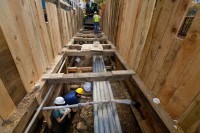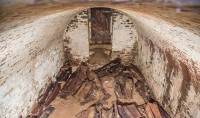 Workers installing a new water main on Washington Square Park East last Tuesday discovered a burial vault probably dating to the early 19th century. Work stopped and Chrysalis Archaeological Consultants were called in to examine the vault at the intersection of Washington Square Park East and Washington Square Park North and carefully excavate the surroundings. They immediately discovered a second vault parallel to the first.
Workers installing a new water main on Washington Square Park East last Tuesday discovered a burial vault probably dating to the early 19th century. Work stopped and Chrysalis Archaeological Consultants were called in to examine the vault at the intersection of Washington Square Park East and Washington Square Park North and carefully excavate the surroundings. They immediately discovered a second vault parallel to the first.
Cameras dropped into the vaults found the chambers are about the same size — 8 feet deep, 15 feet wide and 20 to 27 feet long — with fieldstone walls and barrel-vaulted brick ceilings. The interiors are whitewashed and have a wooden door at one end. The first vault has jumbled skeletal remains of maybe 10 individuals. The second holds about 20 intact wooden coffins.
Numerous coffins, perhaps two dozen, covered the floor of the vault. Some were in disarray but others looked to be in a fine state of preservation. Smaller coffins attested poignantly to the burial of children, when it was not uncommon for families to suffer the loss of their youngest members.
More helpful to historians than anything, perhaps, many of the coffins bore lozenge-shaped ornamental identification plates that will — once they are decipherable — help [Alyssa Loorya, President and Principal Investigator of Chrysalis Archaeological Consultants,] and others put names to the skeletons; and with the names, context; and with context, new stories of old New York.
 With space at such a premium, Manhattan is replete with built-over burials. In fact, the what is now Washington Square Park was first acquired by the city specifically for use as a graveyard. It was farmland in the late 18th century, outside the confines of the city. In April of 1797, the New York City Council bought 90 lots, the eastern two thirds of the future park, for use as a potter’s field, a public burial ground for the indigent. Its brief was expanded every time New York was hit with a yellow fever epidemic (there were four major outbreaks during the lifetime of the cemetery). Victims’ bodies were buried in the potter’s field outside of the city for sanitation purposes. Historians estimate that more than 20,000 people were buried there between 1797 and the cemetery’s closure in 1826.
With space at such a premium, Manhattan is replete with built-over burials. In fact, the what is now Washington Square Park was first acquired by the city specifically for use as a graveyard. It was farmland in the late 18th century, outside the confines of the city. In April of 1797, the New York City Council bought 90 lots, the eastern two thirds of the future park, for use as a potter’s field, a public burial ground for the indigent. Its brief was expanded every time New York was hit with a yellow fever epidemic (there were four major outbreaks during the lifetime of the cemetery). Victims’ bodies were buried in the potter’s field outside of the city for sanitation purposes. Historians estimate that more than 20,000 people were buried there between 1797 and the cemetery’s closure in 1826.
It is unsurprising, therefore, that human remains have been found before during work at the park, starting in 1890 when the foundations were dug for the Washington Square Arch. Architect Stanford White stopped work to document the bones, gravestones, pieces of coffins and one relatively intact coffin. Since then individual graves had cropped up on occasion when the city had cause to dig in the Washington Square Park area, but when in 1965 Con Edison workers broke through an intact burial vault at the northeast corner of the park (the same location where the vaults were found last week), nobody had seen anything like it. The remains of three partially burned coffins and 25 individuals were found in that vault.
There is cartographic evidence from the early 19th century that a large plot extending across the northeast corner of the park from Washington Square Park East to Washington Square Park North and several adjoining blocks belonged to the Scotch Presbyterian Church. Pearl Street Church and Cedar Street Church, both Presbyterian, are each known to have had small cemeteries carved out of the larger lot. The Cedar Street Church cemetery was the larger of the two. It is now the Fifth Avenue Presbyterian Church which has kept excellent records going back to 1808, so it may be possible to identify one of the names on the coffins, should they have been part of the Cedar Street congregation.
All construction work at the site has been halted. By city policy, all burials must be left in place and intact. The water main project is now being redesigned around the vaults.
“Vauts”. Great writing as always.
Except for the atrocious typos. 🙁 Thank you for the correction.
By city policy, all burials must be left in place and intact ? – OK, even in NYC, it seems, some ‘main cemeteries’ are not necessarily big.
A hundred years ago, however, city policies to turn cemeteries into inner-city parks were indeed not completely unheard of. Therefore, as the usual procedure had been to re-inter the coffins in massive out-of-town graveyards, one might wonder if those ‘burials’ are really ‘intact’ or even ‘in place’.
Flags that lead through some of the parks today are -at closer inspection- former tombstones.
I guess that’s not unusual in many cities. Birmingham, Alabama’s zoo and botanical gardens are on a part of a former potter’s field, from the late 1880s.
http://www.bhamwiki.com/w/Lane_Park